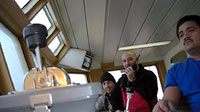

 | |||||||||||||
|
|
Journals 2008/2009Roy Arezzo
July 26, 2008 I am writing my log in the Dry Lab while listening to Simon and Garfunkel coming from Dave's laptop, which sets a mellow tone in contrast to the raging sea outside. The wind has finally found us and although it is not too stormy yet, the barometric pressure is dropping. The winds have kicked up to over 30 knots, stirring up 10-foot seas and making maneuvering on deck somewhat precarious. This morning, I spent some time in the Aft Control Room; located on Deck 1 above the starboard A-frame, observing the deployment of another trail of the Yoyo camera from a warm, dry location. The Aft Control Room is the space occupied by the winch operator who runs the cables that are used to deploy the equipment. For most deployments, the folks working on deck use hand signals and a radio to communicate with the winch operator. Since the Yoyo camera needs to touch the bottom 100 times over a 1 - 2 kilometer transect line the scientists work inside the Aft Control Room to record the details of the deployment and communicate with the winch operator and the bridge regularly.
There are three layers of administration aboard the NBP. The visiting scientists bring the plan and the project objectives. The company that owns the ship, Edison Chouest (ECO), employs the folks who run the ship such as the captain, mates, and engineers. Raytheon Polar Services, Marine Science division, is the liaison between the science team and the ship's operators. They employ the technicians who work the computer systems, electronics and oversee deck operations. The teamwork involved in each deployment is an intricate dance to ensure quality sampling and safety. The Marine Technicians (MT) on deck, Principal Investigators (PI), winch operators, and the bridge all need to communicate for a successful deployment. Coring the bottom requires the ship to hover at an appropriate coordinate; whereas, to drag a net requires that the ship slowly follow a predetermined transect line. The watch leader usually leaves the deck once the instruments start their descent and communicates by radio with the bridge and MT while watching the monitors in the Forward Dry Lab, which display ship's direction/speed, cable tension, sonar, water depth and weather information. There are also video monitors, which display views of the ship's decks. An impressive feature of the NBP is that mostly every space onboard has a monitor to access this information. I can check the weather and view the work on the back deck from my cabin, which is helpful when getting dressed in the morning. The PIs need to be somewhat flexible to adjust to changing weather and limitations due to ice or current. All operations need to be cleared with the bridge. The captain and chief mates have final say. Research vessels like the NBP require an experienced crew. Captain Michael Watson, who attended California Maritime Academy, has been on the NBP since she was built in the 1992. He is originally from California but now resides in Australia. He has always had an interest in being at sea and has worked his way up from smaller ships in the oil field to working as a mate on the NBP until he became the Master in 2004. Chief Mate, Sebastian Paoni is from New Jersey and went to school at the Massachusetts Maritime Academy. He has worked on many different types of ships including tub boats, oil tankers and research vessels. Rachelle Pagtalunan switches on and off as Chief Mate with Sebastian. She has lived all over the world and currently resides in New Zealand. Driving big ships is her second career, after some time in banking she went back to school and attended the California Maritime Academy to work in shipping in an administrative role, but decided she would rather be behind the wheel than on desk. John Higdon is Third Mate on board and in addition to knowing quite a bit about Antarctica he is said to be an excellent photographer and birder. Nick Garay is a young Third Mate and another graduate of California Maritime Academy, where his father attended school with the Captain. Vladimir Repin is also serving as a mate and is our official Ice Pilot.
Between deployments I went into the Bio Lab to spend some time doing more science. Craig had generously offered to put aside some samples and have them shipped to my school and I fixed an assortment of key taxonomical groups in formalin to preserve them for the trip home. Rhian Walker, another research from University of Hawaii, was in the lab separating reproductive structures from coral samples. Although her coral reproduction work is separate from FOODBANCS, by assisting on the project she is able to collect Antarctic specimens. After preparing my samples I had a free hand to help collect DNA for some of the biodiversity analysis that will happen back in the States. I removed muscle tissues samples from sea stars and bivalves, some of which involved smashing clamshells with a hammer. I was feeling good about the lab work and after my watch I was still hungry for more science so I assisted Linda in the microscope room to photograph an interesting planktonic polycheate, which she found in the Tucker trawl.
|
||||||||||||


